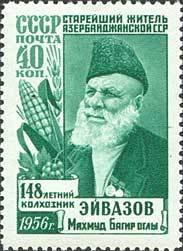Stamp: Mahmud Bağır oğlu Eyvazov (1808-1960), Azerbaijan long liver (Soviet Union, USSR 1956)
Mahmud Bağır oğlu Eyvazov (1808-1960), Azerbaijan long liver (Soviet Union, USSR 1956)
27 August (Soviet Union, USSR ) within release 160th Death Anniversary of Robert Burns goes into circulation Stamp Mahmud Bağır oğlu Eyvazov (1808-1960), Azerbaijan long liver face value 40 Russian kopek
| Stamp Mahmud Bağır oğlu Eyvazov (1808-1960), Azerbaijan long liver in catalogues | |
|---|---|
| Michel: | Mi:SU 1871IIC |
Stamp is vertical format.
Also in the issue 160th Death Anniversary of Robert Burns:
- Stamp - Robert Burns (1759-1796), Scottish poet face value 40;
- Stamp - Ivan Ya. Franko (1856-1916), Ukrainian author face value 40;
- Stamp - Ivan Ya. Franko (1856-1916), Ukrainian author face value 1;
- Stamp - Lesya Ukrainka (1871-1913), Ukrainian authoress face value 40;
- Stamp - Mahmud Bağır oğlu Eyvazov (1808-1960), Azerbaijan long liver face value 40;
- Stamp - Mahmud Bağır oğlu Eyvazov (1808-1960), Azerbaijan long liver face value 40;
Stamp Mahmud Bağır oğlu Eyvazov (1808-1960), Azerbaijan long liver it reflects the thematic directions:
Famous People refers to the fame and public attention accorded by the mass media to individuals or groups or, occasionally, animals, but is usually applied to the persons or groups of people (celebrity couples, families, etc.) themselves who receive such a status of fame and attention. Celebrity status is often associated with wealth (commonly referred to as fame and fortune), while fame often provides opportunities to make money.
The Medal of Honor (MOH) is the United States Armed Forces' highest military decoration and is awarded to recognize American soldiers, sailors, marines, airmen, guardians, and coast guardsmen who have distinguished themselves by acts of valor. The medal is normally awarded by the President of the United States (the commander in chief of the armed forces) and is presented "in the name of the United States Congress." It is often, not strictly correctly, referred to as the Congressional Medal of Honor
Agriculture is the cultivation and breeding of animals, plants and fungi for food, fiber, biofuel, medicinal plants and other products used to sustain and enhance human life.[1] Agriculture was the key development in the rise of sedentary human civilization, whereby farming of domesticated species created food surpluses that nurtured the development of civilization. The study of agriculture is known as agricultural science. The history of agriculture dates back thousands of years, and its development has been driven and defined by greatly different climates, cultures, and technologies. Industrial agriculture based on large-scale monoculture farming has become the dominant agricultural methodology.
O
ld age is the range of ages for people nearing and surpassing life expectancy. People of old age are also referred to as: old people, elderly, elders, senior citizens, seniors or older adults. Old age is not a definite biological stage: the chronological age denoted as "old age" varies culturally and historically. Some disciplines and domains focus on the aging and the aged, such as the organic processes of aging (senescence), medical studies of the aging process (gerontology), diseases that afflict older adults (geriatrics),technology to support the aging society (gerontechnology), and leisure and sport activities adapted to older people (such as senior sport).
Flora is the plant life occurring in a particular region or time, generally the naturally occurring or indigenous—native plant life. The corresponding term for animal life is fauna. Flora, fauna and other forms of life such as fungi are collectively referred to as biota. Sometimes bacteria and fungi are also referred to as flora, as in the terms gut flora or skin flora.





